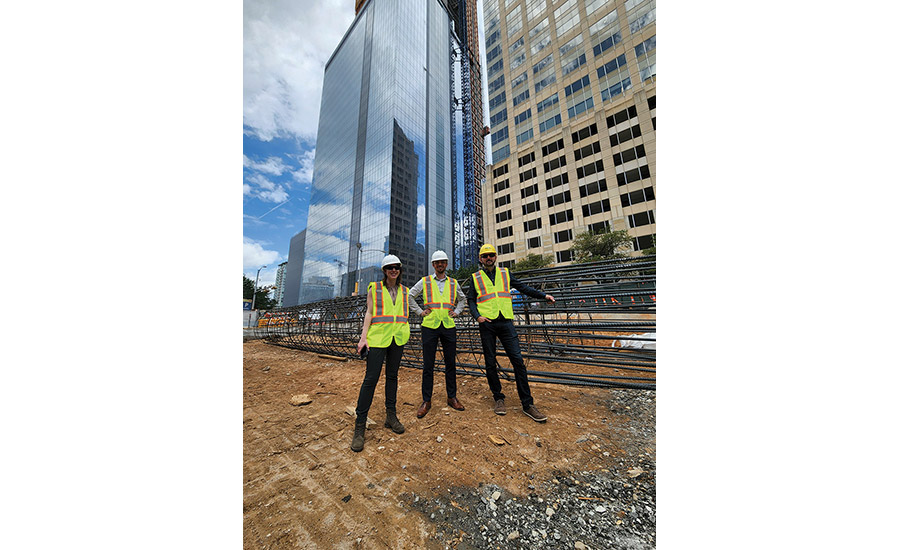ENR 2022 Top 25 Newsmakers
Sean P. Clifton: Structural Engineer Catalyzes Era of More Resilient and Sustainable Skyscrapers Through Improved Wind Design

Clifton (right) with MKA colleagues Kevin Aswegan and Juliana Rochester at the site of the first high-rise to implement performance-based wind design, which is called the future of skyscraper structural engineering for its greater sustainability and resilience and lower cost.
Photos courtesy MKA
Related Article:
Paradigm Shift in Tall Building Wind Design Cuts Material, Cost and Carbon
Back to:
25 Top Newsmakers
Structural engineer Sean P. Clifton owes his career trajectory to the liquid “sloshing” damper. As a graduate student at the University of Texas Austin, he watched with fascination as a guest lecturer demonstrated the action of the device—which damps a tall building’s sway—using a 1-ft-tall “homemade” oscillator to represent a skyscraper.
For Clifton, it was a defining moment. “I was a naive graduate student,” says the senior principal with Magnusson Klemencic Associates (MKA), Seattle. “I didn’t know up from down.”
That started to shift as the lecturer, John Hooper, who is MKA’s director of earthquake engineering, demonstrated how the firm’s then-novel sloshing damper worked. To show its effect, Hooper started the oscillation by tapping the semi-rigid metal-strap legs of the device, which had a small Plexiglas tank of water at the top. It swayed. Then he removed the water from the tank, tapped the device again and the sway increased significantly. Finally, Hooper told the students that in a full-scale building application, the filled concrete tank doubles as a water supply for dousing fires.
Innovation and a dual purpose. Clifton was hooked. He said to himself, “I’m going to go work” at MKA.
That was 15 years ago. And he is happy as a clam. At age 38, Clifton is the youngest of MKA’s 13 shareholders. “A lot of my drive comes from the spirit of innovation at MKA,” he says.
In recent years, Clifton, with MKA support, is driving toward a global paradigm shift in skyscraper wind engineering, called performance-based wind design. PBWD reduces materials, price and embodied carbon in structures taller than 400 ft, says Clifton, who is responsible for the first implementation of skyscraper PBWD in the U.S.—the 321 West 6th Street building, currently rising in Austin.

The site of the first high-rise to implement performance-based wind design, which is called the future of skyscraper structural engineering for its greater sustainability and resilience and lower cost.
Photos courtesy MKA
Clifton decided to pursue PBWD on the 671-ft-tall high-rise because he thought the structure was a good fit for the leading-edge method, which he had been studying for several years. But going first was no simple task. For starters, it meant doing a parallel conventional design, on MKA’s nickel, as backup. Then, Clifton had to pitch the potential advantages to the job’s developers and architects. Finally, he had to convince the authorities.
“Sean had enough guts and drive to implement PBWD for the first time,” says Roy Denoon, a senior principal with the project’s wind specialist CPP Wind Engineering Consultants. “He did a fantastic job” of moving the project forward with the building officials and calculating savings in materials and construction cost, “so we can demonstrate the real value to others considering PBWD,” Denoon adds, saying CPP consequently has several engineer-clients weighing PBWD.
The Austin project also is the first skyscraper designed, approved and permitted using the Prestandard for Performance-based Wind Design, published in 2019 by the American Society of Civil Engineers’ Structural Engineering Institute, with support from several groups, including the MKA Foundation.
“MKA has been so supportive of PBWD since day one,” says Denoon, even financially.
To encourage others to implement PBWD, the team for the Austin building, including CPP and two peer reviewers, shared lessons learned for a revision of the prestandard due out in a few weeks. A discussion to turn the prestandard into a consensus standard will follow, says Jennifer Goupil, director of SEI codes, standards and technical initiatives. To advance PBWD, SEI is hosting a National Institute of Standards and Technology workshop Feb. 23-24 in Reston, Va.
Viral Patel, director of design for structures at Walter P Moore and the Austin tower’s structural peer reviewer, thinks high-rise PBWD will be “standard practice” in 10 to 15 years.




